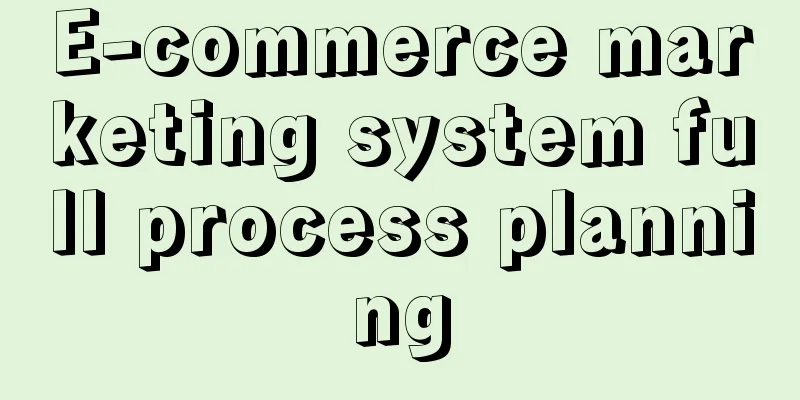E-commerce marketing system full process planning

|
The marketing system is responsible for increasing revenue, conversion, destocking, attracting new customers and stimulating transactions on Internet e-commerce platforms. However, the enterprise back-end tools used by internal company personnel are not as easy to obtain and conduct competitive product analysis as the front-end tools, which makes the system construction of each platform different. The author plans to write a series of articles on how to build a marketing system, a comprehensive analysis of marketing tools, and the intelligence of marketing systems. On the one hand, I hope to have some output, and on the other hand, I hope to communicate with more friends. This article contains the following:
1. Marketing System OverviewAt present, the marketing methods available on the Internet platform are relatively mature. The C-end may have deformation and extension in the packaging and presentation form on the user side, but for the B-end, more attention should be paid to the underlying logic of the marketing system, abstracting the reusable rules under the appearance, and the correlation between the systems. 1. Summary of marketing tool types1) Type induction There are currently about 13 types of activities on the Internet, which can be classified into the following three categories according to usage scenarios:
Single-product activities are suitable for improving conversion rates, activities to increase order value are suitable for increasing average order value and generating related sales, and communication activities are suitable for attracting new customers and conducting off-site activities. 2) Special instructions for coupons and red envelopes It should be noted here that although coupons and red envelopes also belong to the marketing system, they cannot be called activity tools. The difference is: the essence of an activity is a commodity, and the essence of coupons and red envelopes is equivalent to the user's personal assets, and exists as a deduction logic during settlement; there may be a mutually exclusive relationship between activities, but coupons and red envelopes can be superimposed on activities. 3) Two relatively special forms of activities
2. Resource Position ActivitiesGenerally speaking, resource position activities are similar to "columns". These "columns" appear in locations where the platform can provide traffic, such as: home page, home page carousel, search results page, etc., and can contain one or more activity types. Common "columns" include flash sales, group buying, brand sales, etc. Different platforms have different themes and packaging for "columns". Columns and activities can form a one-to-one, one-to-many, or many-to-many relationship. Taking JD.com’s homepage as an example, “JD.com Flash Sales”, “Daily Specials”, “Brand Flash Sales”, etc. can all be defined as “columns”, among which “Brand Flash Sales” is just the name of the “column”. The secondary page can also include various activity types such as buy-one-get-one-free and discounts. 2. Disassembly of the full process modules of the marketing systemThe essence of modularity is to "seek common ground while reserving differences" and abstract the common parts. It is best to break them down into the smallest granularity to facilitate plug-in assembly and quickly build a new type of activity. Now that we have discussed the current forms of platform activities, let’s break down what modules a marketing tool contains: 1. Module 1: Basic information of the activityHere are some common fields in the basic information of activities. There are also a few field information matched by different tools. For example, the order-matching page required for the order-matching category. You can choose to have the system automatically generate or customize the jump. You can add fields according to the specific situation. I will not go into details here. 2. Module 2: Activity Rules TemplateThe activity rules template is actually an "activity access rules template" in essence, which is intended to limit the scope of products and merchants that can be submitted. Rule templates need to be designed dynamically to meet the needs of different activities at different stages. For example: Goods with high unit prices are not suitable for group buying; M yuan for N pieces is more suitable for food and accessories. In addition to focusing on product-side thinking, product managers also need to pay attention to the characteristics of the products, which is very helpful for designing marketing tools. 3. Module 3: Activity Distribution MethodActivities can be issued manually or by system. The difference lies in whether the rules are highly consistent and whether the activities have a fixed rhythm. For example, if there is a flash sale activity with a strong rhythm and time concept, it would be laborious and inefficient if the business had to manually issue the orders at each individual time point. In this case, the system can be set up to automatically issue the orders according to different time dimensions such as day and week. 4. Module 4: Product selection and submission1) Product selection template It should be noted that different activities require different information, so the product selection template when submitting needs to be processed according to the activity type. In addition to the regular activity price, activity inventory, and purchase quantity limit, there is an instant discount amount field (which can be modified for a single sku), etc. 2) Products that can be submitted and verification Product selection and submission should be associated with the activity rule template. The rules are part of the verification logic when selecting and submitting products. They determine whether the product is reportable and whether it meets the requirements of the activity template. This step can help the business select products and increase the chance of selection. General verification also includes product status, such as whether the sold-out status can be reported, and whether a second verification is required before the event starts; 5. Module 5: Activity Approval FlowThe approval flow needs to consider the forward and reverse processes. The approval flow is closely related to the time node and will affect the review status: 1) In the forward process It is necessary to consider whether the participating roles and progress are consistent; if multiple departments are involved in platform activities, it is necessary to consider whether the approval flows between departments are independent; if the application is not reviewed within the time limit, whether it will be automatically rejected, etc. 2) In the reverse process It is necessary to consider the rejection results and the second submission approval process; for example, after the "rejection for modification", who will take over the operation authority, whether the second submission process can be designed differently according to different activity information, etc. For example: If the forward process of the approval flow is shown in the figure below, and if a product is "sent back for modification" in the second review, what kind of product design can be carried out in the second submission process? If the information is not important, such as just a short title for an activity, you can directly choose Option 2 to save review time and improve review efficiency; if it is for inventory, price, etc., you can choose Option 1 as appropriate; then what if the "return for modification" can be modified directly by the "first instance" instead of by the "applicant"? Further thinking can be done on the direction of data flow. 6. Module 6: Marketing Data Report
Report data can help with business planning, decision-making, and activity analysis. Its scope of application covers activity creation, during activities, and after activities, and is an indispensable tool for operations personnel. 1) Provide objective and accurate activity data We can roughly plan from two dimensions: traffic data and transaction volume:
In the marketing system, different activities focus on different data. For example, group buying activities also need to focus on the number of group orders, the number of group orders, the number of group orders, etc. 2) Discover changes in data indicators Here we need to process the data results, further compare the data values, and observe the data curves. Some comparative analysis values can be added to the overall data, such as sales month-on-month, compared with yesterday, last week, and other data fields with time properties, so that we can feel the data changes more intuitively. If you set a range of values, an early warning will be issued when the data fluctuates abnormally, making it easier for the business team to analyze the reasons for the data changes. Although data reports are generally presented in the BI system, I prefer to display real-time data in the activity system at the same time to facilitate on-site observation and adjustment by operations staff. 7. Module 7: Marketing system authority systemBecause marketing systems often involve cross-ends (platform end, merchant end), multiple roles, multiple states and multiple operations, the design of roles and permissions requires extra rigor, otherwise it is easy to cause confusion. The design methods in different platforms may be different. Some platforms determine functions and operable items based on roles, while others determine functions and operable items based on permission points, and then add permission points to different roles. This is determined by the platform's permission system. This part requires planning the status/role/permission correspondence table during the product design phase, which is not only used for technical development, but also for permission configuration after the function is launched. As shown in the following table: First, the system will default to all roles having the "Details" permission. Secondly, combine the status and authority to determine, for example, in the CEO review state, find the person with "CEO review" authority and display the "go to review" operation: 3. Differences in the design of ToC and ToB marketing toolsI was once responsible for the product design of the marketing module in a ToB e-commerce app in a project, and found that there are some differences in the design of the two, which I can briefly introduce here. Let's first look at the differences between the ToC side and the ToB side: It can be seen from the table that activities suitable for the C-end, such as group buying, are not suitable for the B-end. Therefore, when designing the ToB marketing module, we planned columns with regional characteristics such as "local distribution" and "control area and price" to control logistics timeliness and reduce transportation and packaging costs. We also created a B-side special system and page shopping cart to shorten the transaction path. Carry out personalized marketing strategies, recommend products based on the store’s main categories and offline store sales data, accurately reach users, and increase conversions. Finally, we achieved good results. 4. Final ThoughtsThe marketing system is a huge system that is closely related to the front-end purchasing transaction process and the back-end supply chain. At the same time, there are intersections with the CRM system, order system, and financial system. If you plan a marketing system from 0-1, you should pay attention to the synergy between the various systems. If you are interested, I will share it in future articles. Author: Chen Ran Source: Operator |
<<: Live streaming can sell products, so why do brands still need to spend money on advertising?
Recommend
Changsha tea tasting tea arrangement
Content: Changsha new tea arrangement appointment...
The most detailed tutorial on how to maintain a Douyin account
Everyone who makes short videos knows about Douyi...
Congratulations! The second "space meeting"! The Shenzhou 16 astronauts successfully entered the Chinese space station
After the Shenzhou 16 manned spacecraft entered o...
Is the 8K TV that has dominated technology exhibitions an inevitable trend or have manufacturers run out of tricks to sell their products?
Different from the focus of most young consumers ...
Spring Festival travel ticket grabbing war: No direct tickets? These tricks can help you get train tickets (with detailed tutorials)
Spring Festival travel season: the “homecoming ba...
Useful information sharing | 3 tips to crack the "metaphysics" of short video material explosion
From reading articles, to looking at pictures, to...
The warmest winter in Sichuan is here!
This is the most unfamiliar scenery in Sichuan, a...
Lays Potato Chips-Brand Marketing Strategy!
As the saying goes, food is the most important th...
Toyota is using cow dung to build a power station because Tesla criticized hydrogen fuel cell vehicles for not being environmentally friendly
In addition to Tesla and other manufacturers who ...
Sony's gaming boss: Virtual reality will be the future of gaming
Fortune magazine wrote in this week's article...
Japanese companies have been involved in emissions scandals, and Japanese media revealed how to test car fuel efficiency
Recently, according to media reports, after Mitsu...
Morgan Stanley: India will become Apple's next China
China's economic growth, the increase in the ...
[Practical] Android Data Binding from resistance to love
1 Introduction How to implement the following int...
Danger! Beware of these 4 conditions that may occur to your parents after COVID-19
On the first day after infection, there may be no...
Do you know the first river in our country named after a poem?
Qishui soup, Gradually the carriage curtains and ...




![[Practical Information] H5 Production Tools Competition!](/upload/images/67cc3d2625fa9.webp)




